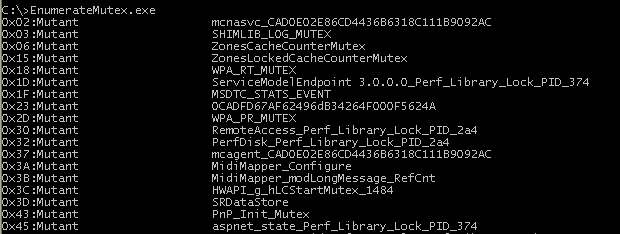A mutex, also called a lock is a program object commonly used to avoid simultaneous access to a resource, such a variable.
It’s used in concurrent programming to allow multiple program threads to share the same resource.
Mutexs are usually used by malware creators to avoid the infection of a system by different instances of the same malware.
When the trojan infects a system, the first step is to obtain a handle to a “named” mutex, if the process fails, then the malware exits.
The easiest way to check for the presence of a Mutex is using the CreateMutex Function
HANDLE WINAPI CreateMutex( __in_opt LPSECURITY_ATTRIBUTES lpMutexAttributes, __in BOOL bInitialOwner, __in_opt LPCTSTR lpName );
This is the same function that malware uses for checking if the system is infected so one approach to detect the presence of a piece of malware is trying to obtain a handle to the created mutex.
Here is a list of some malwares (md5’s) and the Mutex created:
60f733d6d0b077e4a668fb49aab44a30, xx464dg433xx16 fb663100308285afb4debdcab8d67fe2, 6E523163793968624 47c6313ec393d0c55d57529e2a9a418d, Security Tool 72631c3c853d706daf1153b3c8fea54f, psec_once c37f47c9071eed101a67532e5d412171, YMING cdcd59a5fb80808cad7376c001586c6e, 290541776 6013de3fed84d40bb173ec23f408a67e, mymutsglwork 62a3f867becfea136aea4ec83a4d9c44, 5BB0650C 5f33aa0b5660bc932af969301635d818, XGBPPAQHSE 2e40abf579e4d8d5d1ba7df34d5e507a, _!SHMSFTHISTORY!_
I’ve uploaded a small piece of code in .NET (console) using PInvoke that takes the name of the mutex to check for.
- Source Code
http://alienvault-labs-garage.googlecode.com/svn/trunk/CheckMutex.cs[no longer available] - Binary
http://alienvault-labs-garage.googlecode.com/svn/trunk/CheckMutex.exe[no longer available]
(Tested on Windows XP SP2 and Windows 7)
Example:
You can use this small application to quickly check if a system is compromised if you know the name of the mutex created by the malware.
In the previous post, we talked about the Windows Kernel Objects as well as the “Object directories”.
We learnt how to query a directory using WinDBG and we found that Mutex as well as other kernel objects are present inside directories.
So now I will explain how to query object directories from user land via NtQueryDirectoryObject to list mutexs present in the system.
We will use the functions NtOpenDirectoryObject and NtQueryDirectoryObject
NTSTATUS WINAPI NtOpenDirectoryObject( __out PHANDLE DirectoryHandle, __in ACCESS_MASK DesiredAccess, __in POBJECT_ATTRIBUTES ObjectAttributes );
NTSTATUS WINAPI NtQueryDirectoryObject( __in HANDLE DirectoryHandle, __out_opt PVOID Buffer, __in ULONG Length, __in BOOLEAN ReturnSingleEntry, __in BOOLEAN RestartScan, __inout PULONG Context, __out_opt PULONG ReturnLength );
So the best approach to enumerate the Mutex objects is to traverse all the directories beginning with the root directory (”“\”“) and check for “Mutex objects” inside the directory.
We have to take into account that a directory may contains another directory so we have to traverse all of them.
Here is another piece of code to enumerate all the mutex present in the system:
- Source Code
http://alienvault-labs-garage.googlecode.com/svn/trunk/EnumerateMutex.cs[no longer available] - Binary
http://alienvault-labs-garage.googlecode.com/svn/trunk/EnumerateMutex.exe[no longer available]
(Tested on Windows XP SP2 and Windows 7)
Example:
Remember that Windows Objects belongs to a namespace and each user session has a different namespace so you will retrieve different results from different user sessions.
I was looking at some mutex results an then I found these:
0x16F:Mutant VMwareGuestDnDDataMutex 0x170:Mutant VMwareGuestCopyPasteMutex
I think is another interesting trick to detect the presence of a system running inside Vmware.
Searching the Internet I found this report from ThreatExpert about a malware called W32.Neshuta that creates exactly the previous two mutexs.
So the question is if the malware checks for the presence of Vmware with this technique (I bet you a beer) or it uses the same mutants to hide and deceive computer users.

